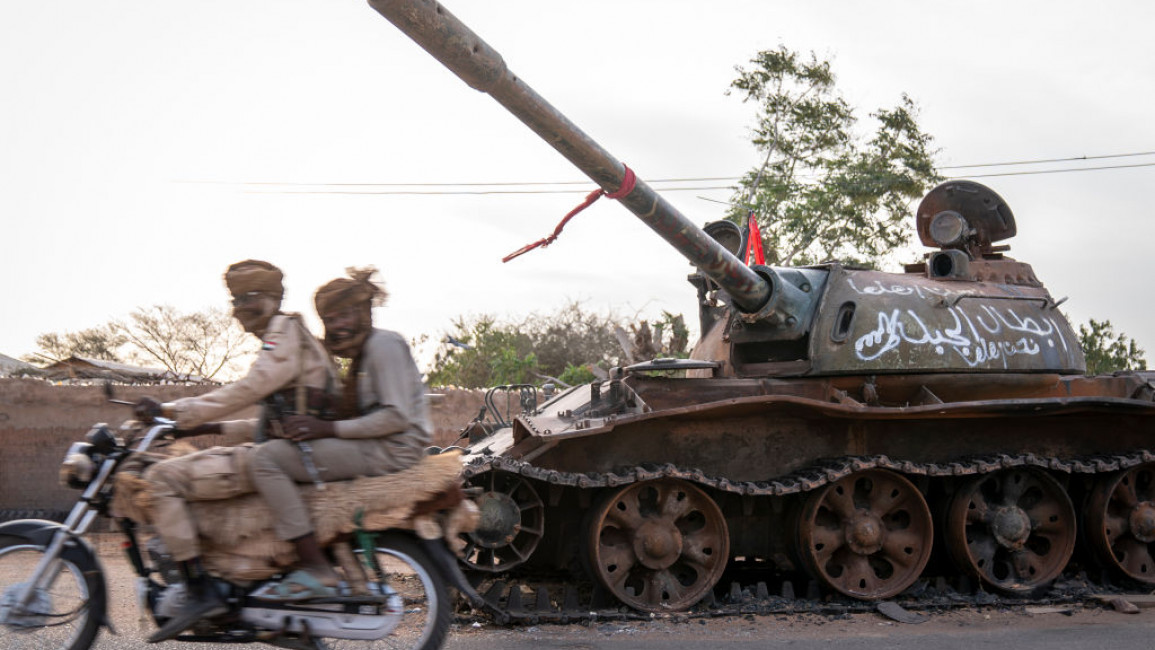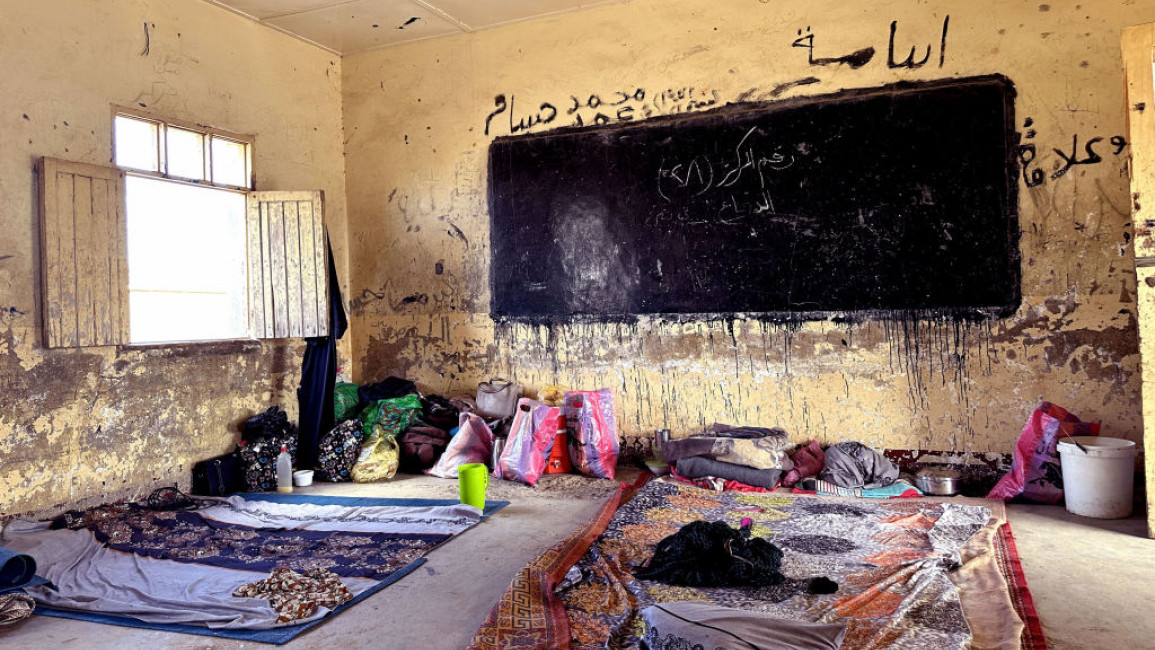
How Sudan is sliding towards famine after one year of war

One year into its devastating civil war, Sudan is experiencing its highest-ever levels of food insecurity as the country stands on the brink of the world’s largest hunger crisis.
An estimated 18 million Sudanese - or around 40 percent of the nation - face severe levels of hunger, with nearly three million children suffering from acute malnutrition. Reports of people dying from starvation have been trickling in for some time now.
Some of the states hardest hit by the fighting, such as Darfur, Kordofan, and Gezira, have traditionally been regions of high agricultural production, but the war has made it very difficult, if not impossible, to maintain activity in the fields.
The displacement of millions and the military recruitment campaigns by both warring parties, now in full force, have in turn depleted the labour force.
The disruption of the financial sector, concentrated in the devastated capital of Khartoum, has left many farmers without access to the credit they relied on to pay for the machinery and the inputs they need to cultivate the land, such as seeds and fertiliser.
"An estimated 18 million Sudanese - or around 40 percent of the nation - face severe levels of hunger, with nearly three million children suffering from acute malnutrition"
The fierce fighting in the capital, and widespread looting by the Rapid Support Forces (RSF), have also dealt a fatal blow to the country’s agri-food industry centred in the nation’s economic heartland.
And food prices have soared by an average of more than 80% compared to pre-war levels, according to the UN; far more so in the worst-affected areas.
“These challenges will become cyclical unless sustained humanitarian and agricultural development support to communities is rapidly scaled,” Barrett Alexander, director of programs at Mercy Corps, an organisation that has been working in Sudan since 2004, told The New Arab.
Local cereal production has plunged by almost half from last year, according to OCHA. Sudan’s agriculture ministry, meanwhile, has stated that shortfalls in state revenue and supply chain disruptions have led to wheat imports being cut to just half of the usual volumes purchased from abroad, enough to cover only around one-third of the estimated demand.
The drop in harvests and access to feed is also affecting Sudan’s livestock and animal-sourced food, another key component of the food security and profitable exports of the country, which is estimated to have over 100 million head of cattle.
The scale of the crisis is all the more alarming because it has intensified during the country’s harvest season, from October to February, when there is usually more food available. An even more dire situation is now expected by mid-year.
“What is most alarming is that at nearly every stage of the food system lifecycle people will face significant challenges,” Alexander told TNA.
A recent study by Clingendael, a Dutch think tank, forecasted that by June about 40% of Sudan’s population will have access to less than half the amount of energy they need. About 15%, or about seven million, will have access to less than one-third.
The prospect is particularly grim for children, pregnant women, and new mothers: almost 230,000 could die in the coming months due to hunger, according to the latest figures from Sudan’s Nutrition Cluster, comprising the UN, the Ministry of Health and NGOs.
Although a famine has not yet been formally declared, many warn that Sudan is rushing in that direction and soon it will be too late to intervene.
“Only when enough households are starving, enough children are acutely malnourished, and enough people die each day are catastrophic hunger levels or famine declared,” noted Anette Hoffmann, a senior researcher at Clingendael and author of the previous study.
“By that time, any food aid will come too late to rescue anyone in this category,” she said.
|
|
Sum of challenges
Rising levels of hunger come as part of one of the most rapidly unfolding humanitarian crises in the world, according to UN agencies. Today, as many as 25 million people - including more than 14 million children - are in need of humanitarian aid in Sudan.
Malnutrition, especially at acute levels, weakens the immune system, increases morbidity and mortality, and makes it easier for vulnerable people to contract diseases.
Between May and September last year, shortly after the onset of war, more than 1,200 children under five died in camps in the White Nile state, in southern Sudan, from a lethal combination of malnutrition and an outbreak of measles, the UNHCR reported at the time.
The situation is further compounded by the devastation of the country’s health system. Between 70 and 80% of hospitals in the main combat zones are out of service, according to the WHO, leaving around 65% of the population deprived of health care.
The war has also caused the world’s largest IDP crisis in Sudan. Some 6.5 million people, according to the IOM, have been forced to flee in search of more stable locations. But this is straining the already limited resources of host communities, including food.
"Only when enough households are starving, enough children are acutely malnourished, and enough people die each day are catastrophic hunger levels or famine declared. By that time, any food aid will come too late to rescue anyone in this category"
The situation is most critical in the refugee camps in Darfur. An assessment by Doctors Without Borders of the situation in Zamzam camp, one of the largest and oldest in Sudan, revealed in February that all emergency thresholds for malnutrition have been reached.
MSF estimated that a child dies there every two hours.
“In all the displacement camps in Darfur the humanitarian situation is dire, requiring food and medicine,” said Adam Rojal, a spokesperson for Darfur’s refugees and IDPs.
Rojal told The New Arab that in South Darfur’s Kalma camp, another of the largest camps in the region, 80% of families eat only one meal a day, which often lacks basic nutrients, according to a study they have conducted together with civil society organisations.
Despite the vast needs, humanitarian agencies decry that they have been unable to scale up operations to the levels required due to an array of obstacles from both warring sides. These include bureaucratic hurdles, limits to entry points, lack of security guarantees, attacks on humanitarian workers, widespread looting, and telecommunications outages.
The UN announced in early March that it had received guarantees from the Sudanese authorities to expand cross-border movements of aid slightly. However, the new access points remain limited, mainly controlled by groups allied with the army, and the procedures to be followed remain to be fully defined and implemented, according to OCHA.
The disruption of maritime traffic in the Red Sea, caused by the attacks of the Houthis in Yemen against ships launched in the wake of Israel’s genocidal offensive in Gaza, poses an additional challenge to deliver supplies to Sudan, which mainly entered via Port Sudan.
On top of the issues faced inside the country, humanitarian agencies and their operations are also constrained by a lack of funding. So far, UN agencies have only secured 6% of the funding they have requested for their response plan.
“The global community in the last several years has proved itself to be myopic, only able to focus on one crisis at a time,” Alexander, from Mercy Corps, said.
|
|
“Unfortunately, despite the deteriorating security and access situation, Sudan being the largest internal displacement crisis in the world, and famine warning bells beginning to ring, little to no attention has been paid to Sudan,” he added.
The major humanitarian agencies have been able to distribute food to date to over ten million people, according to data from the Food Security and Livelihoods Cluster (FSL). The WFP is the backbone of these operations and has reached over five million people.
The limits of the humanitarian response, however, are underscored by the fact that 9 out of 10 people in a hunger emergency are in areas accessible to humanitarian agencies. The WFP regrets that only one in five of those most in need have received their aid.
"Despite the deteriorating security and access situation, Sudan being the largest internal displacement crisis in the world, and famine warning bells beginning to ring, little to no attention has been paid to Sudan"
Local initiatives
The daunting challenges in delivering volumes of aid to Sudan that come anywhere close to meeting famine relief needs have underscored the urgent need to seek alternatives, rethink the humanitarian response, and put local initiatives at the centre.
In the second half of 2023, the UN Food and Agriculture Organization (FAO) distributed seeds to one million farmers in agricultural regions of Sudan to help them produce enough grain to at least cover the basic needs of 13 to 19 million people by December.
The FAO has also noted that markets in some of the areas of the country that remain most isolated because of the war maintain some activity. And many have called for transferring cash to vulnerable people in these areas so that they can directly buy food.
Some experts have also called on the international community to make greater efforts to assist Sudan’s private sector, particularly small businesses, which have maintained some activity that is crucial to sustain in the current context despite having been badly affected.
A key actor in these efforts is the emergency response rooms, groups of volunteers well rooted in many neighbourhoods that emerged from the strong tissue of civil society and revolutionary movements that existed in the country before the war. Now, they have mainly turned their attention to critical services, including community kitchens.
The funds that allow these groups to sustain these efforts come mostly from the Sudanese diaspora and local entities and individuals. And they have proven to be very effective and well-organised even in war-torn areas, providing a lifeline to tens of thousands of people.
A member of the East Nile ERR told The New Arab that they started community kitchens with five pilot projects. Today, there are 150 covering some 27,000 families.
Despite their key role, members of these groups have been targeted by both warring sides, often on accusations of collaborating with their rivals. Frequent internet outages have also dealt a serious blow by disrupting, or preventing, the receipt of money sent to them.
The member of the East Nile ERR noted that network outages have forced the intermittent closure of over 100 community kitchens in the area and said that their fund needs are dire.
“The importance of these kitchens lies in the fact that they provide food for many citizens within the locality who do not have a family or money to provide for their food needs,” the volunteer said. “These solidarity kitchens have become a safe haven for them to obtain their food needs in a way that preserves their dignity and humanity.”
Join the conversation: @The_NewArab



![President Pezeshkian has denounced Israel's attacks on Lebanon [Getty]](/sites/default/files/styles/image_684x385/public/2173482924.jpeg?h=a5f2f23a&itok=q3evVtko)



 Follow the Middle East's top stories in English at The New Arab on Google News
Follow the Middle East's top stories in English at The New Arab on Google News


